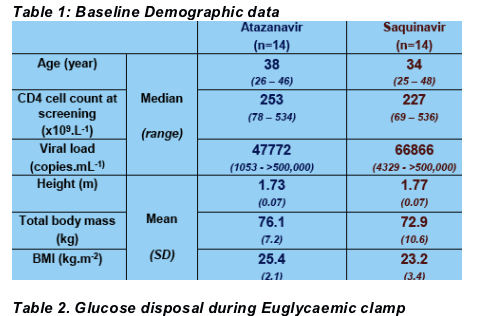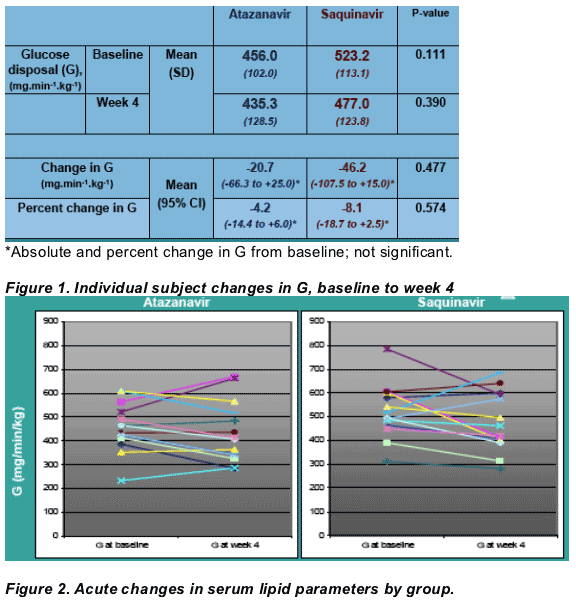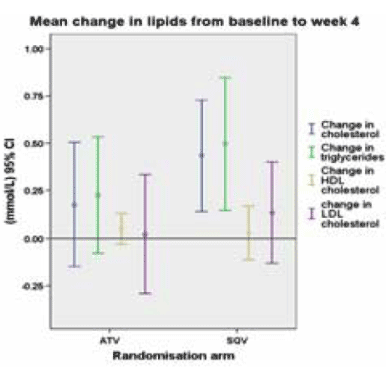 |
 |
 |
| |
Effects of atazanavir or saquinavir QD with ritonavir 100 mg and tenofovir/emtricitabine as initial therapy for HIV-1 infection on peripheral
glucose disposal; a randomised open-label study
|
| |
| |
Akil Jackson, Nimesh Patel, Gary Lo, Brian Gazzard, Graeme Moyle
Chelsea and Westminster Hospital, London, UK
AUTHOR SUMMARY
- In this study, mean changes in glucose disposal (G) over 4 weeks therapy were a decrease of 4.2% with atazanavir and of 8.1% with saquinavir (neither the change from baseline nor the difference between groups was statistically significant).
- The changes in G within individuals in both groups were highly variable in both treatment groups (Figure 1).
- Early changes in lipid parameters were modest, from baseline to week 4; only statistically significant change observed was an increase in total cholesterol and triglycerides in patients on saquinavir.
INTRODUCTION
Some HIV-1 Protease inhibitors are associated with insulin resistance. A variety of methods have been used to assess this in clinical studies; of these the hyperinsulinaemic euglycaemic clamp has been considered to be the most precise measure.
Healthy volunteer studies of un-boosted 400 mg atazanavir (ATV) for 5 days did not alter glucose disposal rates during hyperinsulinaemic euglycaemic clamp1. Changes observed in similar studies have included a 17% reduction in glucose disposal on indinavir for 4 weeks2 and a 10 % lower insulin sensitivity index with atazanavir/ritonavir (ATV/r) 300/100mg compared with a 23% reduction with lopinavir/ritonavir3 over 5 days administration. There are no data on the effect of either atazanavir or saquinavir on glucose disposal when given as part of initial regimens to HIV-1 infected subjects.
OBJECTIVES
We aimed to investigate the early effect of treatment over 4 weeks on the change from baseline in insulin-mediated glucose disposal with either atazanavir or saquinavir QD with ritonavir 100 mg.
METHODS
This was a single centre, prospective randomized, open-label trial comparing
saquinavir/r 2000/100 mg QD versus atazanavir/r 300/100 mg (with TDF/FTC) on
glucose disposal rates during a standard hyperinsulinaemic euglycaemic clamp
method4 performed at baseline and after morning dosing at week 4. Patients were recruited from the out-patient clinic at the Chelsea & Westminster hospital and were screened to include:
- Male patients aged 18 to 60
- No previous antiretroviral treatment experience, with a clinical indication for initiating therapy
and to exclude:
- Active wasting or opportunistic disease
- Any disturbance of metabolic homeostasis
- Medications likely to have an impact determination of insulin sensitivity by euglycaemic clamp
- Acute or chronic viral hepatitis.
Glucose disposal (G) was determined during the final 60 minute of a 180 minute
hyperinsulinaemic (40 mUnit.m2.min-1) euglycaemic clamp and expressed as the rate of glucose disposal per unit body mass (mg.min-1.kg-1). A sample size of 32 subjects was determined based on results of a previous study with indinavir on HIV-negative subjects.
RESULTS
32 subjects were recruited and randomly allocated to each of the treatment arms.
Twenty-eight (28) subjects obtained results from both baseline and week 4
euglycaemic clamp studies.



References
1. Noor MA, Parker RA, O'Mara E, et al. The effects of HIV protease inhibitors atazanavir and lopinavir/ritonavir on insulin sensitivity in HIVseronegative healthy adults. AIDS. 2004 Nov 5;18(16):2137-44
2. Noor MA, Seneviratne T, Aweeka FT, et al. Indinavir acutely inhibits insulin-stimulated glucose disposal in humans: a randomized, placebo controlled study. Aids 2002,16:F1-8.
3. Noor MA, Flint OP, Maa JF, et al. Effects of atazanavir/ritonavir and lopinavir/ritonavir on glucose uptake and insulin sensitivity: demonstrable differences in vitro and clinically. AIDS. 2006 Sep 11;20(14):1813-21.
4. DeFronzo R, Tobin J, Andres R. Glucose clamp technique: a method for quantifying insulin secretion and resistance. Am J Physiol Endocrinol Metab 1979;237:E214Ð 223.
Disclosure: This study was supported by a grant from Roche pharmaceuticals.
|
| |
|
 |
 |
|
|